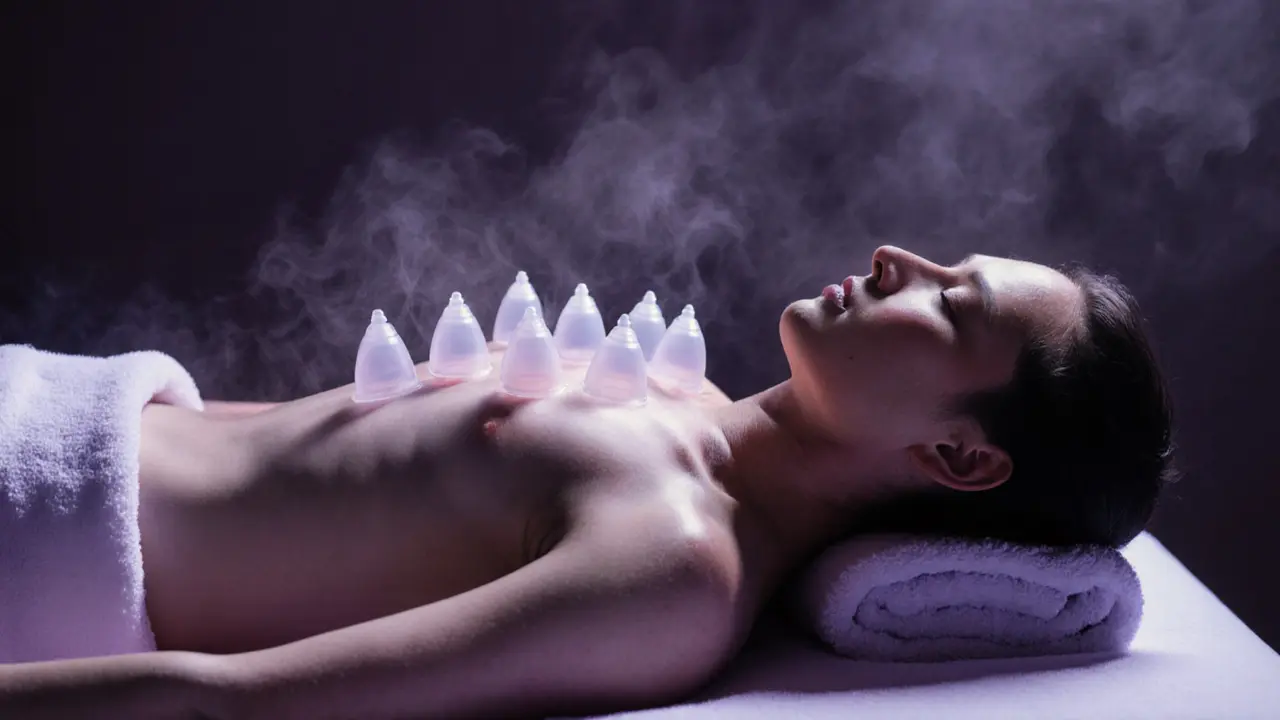Red, circular marks on swimmers’ backs turned cupping from ancient ritual to a spa headline overnight. The promise? Pulling out toxins. Let’s be real—any wellness treatment that says it draws out built-up junk has a magnetic pull. I’ve watched clients in Dubai come in swearing by cupping for everything from chronic soreness to ‘bad energy.’ But does it really suck out toxins? Let’s dig into what’s actually going on, according to science and real-life spa pros who see this every day.
Why is cupping therapy said to remove toxins?
Cupping therapy’s roots stretch thousands of years deep—in Chinese, Egyptian, and Middle Eastern medical traditions. Back then, folks believed illness was caused by ‘bad blood’ or blockage in your body’s flow. Healers used cups and suction to pull out “toxins” through the skin, with marks sometimes seen as proof the treatment worked. That language stuck around, even if the science evolved.
The classic explanation is simple: the cups create a vacuum, drawing blood and fluids toward the surface. Along with that, the claim is that stagnated or dirty blood (aka ‘toxins’) leaves the tissue, boosting healing and clearing blockages. In TCM (Traditional Chinese Medicine), cupping is all about moving “qi” or life energy, often blaming pain on stuck energy and blood.
Fast-forward to today, the term “toxins” floats around almost every spa menu in Dubai. But ask two massage therapists what these toxins are, and you’ll get different answers—some say it’s lactic acid, others mention metabolic waste, and some throw in mysterious “environmental toxins.” In reality, science hasn’t shown cupping pulls toxins like heavy metals from your blood, but there’s more nuance to how it might help flush out local waste through increased blood flow and lymphatic drainage.
So, when someone says cupping removes toxins, it’s usually a mix of tradition, belief, and a basic understanding of how boosting circulation could help your body’s own detox systems. The real story? It’s not about toxins exiting through the skin. It’s mostly blood movement and recovery support, with origins in centuries-old healing logic.
What does the science say about toxins and cupping?
Let’s get specific. Medical researchers have tried to answer this one by looking at what changes after cupping. When you attach a cup to the skin and create suction, blood rushes to the area, and it can bruise. Some small studies found local changes: things like increased circulation, reduced inflammation, and possibly even changes in pain signals. But laboratory tests don’t show toxins pouring out of cupped skin or floating off into the air.
That’s not to say cupping doesn’t take effect physically. The suction does cause a sort of controlled trauma. New blood moves in, flushing out some of the stuff your cells don’t need, like old immune cells or waste products from muscle use (think after a tough workout). For example, there’s evidence that cupping can slightly increase what the body flushes out via the lymphatic system. The lymph system handles cellular waste, bacteria, and excess fluid. When cupping boosts lymph flow, it’s not exactly toxins being sucked out—but your body may process waste a bit faster.
Some cupping fans will mention lactic acid. After tough exercise, lactic acid builds up in muscles and can cause soreness. Yes, cupping’s increase in blood flow may help clear it out, but it’s not unique—a brisk walk, a sauna, or even a massage can do the same. So, while the feeling of “lightness” after cupping is real for many, there isn’t a direct pull of heavy metals, pesticides, or environmental toxins from your bloodstream into the cup.
In a 2022 review published in the Journal of Traditional and Complementary Medicine, researchers concluded that the evidence for actual toxin removal through cupping remains thin. They did note people report relief with conditions like muscle knots, chronic neck pain, and even migraine—but that’s more about stimulating your body’s healing circuits than yanking toxins out through your skin.
What’s really happening under the skin during cupping?
Picture a small glass or silicone cup suctioned tight against your skin. It creates low pressure inside, drawing the skin up. Within seconds, you see redness—blood is coming to the rescue, delivering immune cells, nutrients, and oxygen. Tofu, my sassy tabby cat, once pawed at my own cupping marks, clearly convinced I’d been in some sort of scuffle. But all that redness? It’s capillaries breaking a little, and your body starting a local clean-up job.
As the blood pools, there’s a minor injury response. White blood cells will mop up debris, clear out old blood, and restart tissue repair. You can almost think of cupping as controlled micro-damage: enough to get your immune system and circulatory system revved up but not enough to hurt you. For athletes or people with stubborn muscle knots, that means faster clearance of things like excess interstitial fluid and inflammation.
One tip I share: after a cupping session, drink lots of water and maybe go for a light walk. This helps your lymphatic system keep moving and remove any waste loosened up by the increased blood flow. Clients who hydrate well after cupping usually see their marks fade a bit faster, too—bonus for bikini season at Jumeirah Beach.
But about actual “toxins”: sweat glands, the liver, and the kidneys do most of your body’s real heavy-duty filtering. Cupping won’t take the place of a healthy liver or good hydration, but it does give your body a gentle nudge to do its regular maintenance. You may hear stories of dark marks or even a bit of blistering as proof things are leaving the body, but these are just signs of local blood leakage and healing, not a dump of dangerous chemicals.

Is there proof that cupping removes specific toxins?
This is where things get tricky. If you ask for a list of “toxins” cupping specifically removes, science draws a blank, but ancient texts have plenty to say. In Chinese medicine, “toxin” is often a catchall for whatever’s causing imbalance: stuck energy, inflammation, or bad blood. That’s a different mindset from Western medicine, which wants proof down to the molecule.
Modern studies haven’t shown that cupping pulls out lead, mercury, or harmful chemicals stored deep in your fat or organs. Instead, the effects are more subtle—relieving muscle tension, resetting the nervous system, and even boosting mood (thanks, endorphins). One thing that does happen: slight increases in waste byproducts removed by the lymph system (like bits of dead cells, excess protein, and spent immune cells). But these are routine maintenance, not a dramatic detox dump.
If you want a real-life example, think about the bruises you see after a hearty cupping session. Those marks are just blood pooled under the skin, gradually reabsorbed by your body. There’s no dark ‘toxin goo’ coming out. Occasionally, you’ll see “wet cupping” (Hijama) done in the Middle East, where small cuts are made after suction, and some blood is drawn out. Still, modern research hasn’t found that this blood contains high levels of toxins compared to regular blood samples.
So why do so many people say they feel better? Part of it comes down to increased local circulation and a feeling of release. One tip if you’re trying cupping for the first time: communicate with your therapist. If you’re hoping for detox effects, pair cupping with things that really support your liver and kidneys (think: clean eating, hydration, sweating it out in the sauna).
What’s the best way to get benefits from cupping in Dubai spas?
Dubai’s spa scene offers every style you can imagine: dry cupping, wet cupping, fire cupping, and even cupping as part of full-body massage rituals. If you want the feeling of a gentle “reset” without any questionable claims, look for reputable therapists who can walk you through what’s happening. Experienced therapists in Dubai know how to adjust pressure, cup placement, and session length to avoid side effects.
After your session, drink plenty of water (don’t skip this—it really helps). Give yourself time to rest. Avoid hot showers or aggressive scrubbing for at least 24 hours so your skin recovers properly. Reputable spas also sterilize their cups and tools, so don’t be afraid to ask about hygiene protocols.
For best results, consider combining cupping with other proven wellness habits: regular movement, balanced diet, and stress reduction (I’m obsessed with meditation apps—my favorite for unwinding after a tough Dubai workday). Tofu, my cat, would likely tell you naps are vital too. If you’re already feeling run down or fighting illness, check with your doctor before trying cupping, as it isn’t suitable for everyone—especially people with bleeding disorders, skin infections, or pregnancy.
Finally, don’t expect miracles. Cupping won’t unclog your arteries or erase years of poor diet. But for many—a sweaty athlete with sore muscles, or a desk worker with a stiff neck—cupping can offer a cozy boost. The main detox is about muscle recovery, circulation, and the deep relaxation that comes from old-school spa rituals done right.
FAQ
- Does cupping actually remove toxins from your body? There’s no scientific data showing cupping pulls toxins out through your skin, but it does boost blood flow and may support your body’s natural detox processes.
- What do the cupping marks mean? Red or purple marks after cupping are caused by blood pooling under the skin and are a sign of increased circulation, not confirmation of toxin removal.
- Can cupping treat specific diseases or chronic conditions? Cupping isn’t a cure for disease, but people report relief from muscle pain, tension, and sometimes headaches when used alongside other treatments.
- Is it safe to try cupping at home? Professional therapists can minimize risk of burns, cuts, or excessive bruising. At-home kits are riskier if you lack training—best to try a reputable Dubai spa first.
- What should I do after a cupping session? Drink plenty of water, avoid hot showers for a day, and let your body rest to make the most of any benefits.



